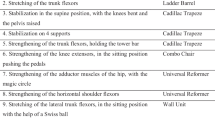Abstract
Introduction and hypothesis
This study seeks to determine the impact of prolapse surgery on body image in women with pelvic organ prolapse.
Methods
Case-control study of 76 sexually active women with greater than or equal to stage II prolapse planning reconstructive surgery and 67 women with lesser than or equal to stage I prolapse. Questionnaires/examinations were completed at baseline and 6 months postoperatively for cases and at baseline for controls: Body Exposure During Sexual Activity Questionnaire (BESAQ), Body Image Quality of Life Inventory (BIQLI), Pelvic Floor Distress Inventory (PFDI)/Pelvic Floor Impact Questionnaire (PFIQ), and Pelvic Organ Prolapse–Incontinence Sexual Function Questionnaire-12 (PISQ-12), and the Pelvic Organ Prolapse Quantification (POPQ) examination.
Results
Baseline and 6-month data were available for 64 case women with mean age of 60 ± 8 years, mean body mass index of 28 ± 5 kg/m2, 96% Caucasian, and 83% postmenopausal. Baseline POPQ stage distribution was: stage II 14%, stage III 78%, and stage IV 8%. BESAQ, BIQLI, PFDI/PFIQ, and PISQ-12 postoperative scores significantly improved compared to preoperatively (all p ≤ 0.001).
Conclusions
Body image, sexual function, and pelvic floor symptoms improve after prolapse surgery.
Similar content being viewed by others
References
Bump RC, Mattiasson A, Bo K, Brubaker LP, DeLancey JO, Klarskov P et al (1999) The standardization of terminology of female pelvic organ prolapse and pelvic organ dysfunction. Am J Obstet Gynecol 180:299–305
Rogers GR, Villarreal A, Kammerer-Doak D, Qualls C (2001) Sexual function in women with and without urinary incontinence and/or pelvic organ prolapse. Int Urogynecol J 12:361–365
Brown JS, Posner SF, Stewart AL (1999) Urge incontinence: new health-related quality of life measures. JAGS 47(8):980–988
Barber MD, Kuchibhatla MN, Pieper CF, Bump RC (2001) Psychometric evaluation of 2 comprehensive condition-specific quality of life instruments for women with pelvic floor disorders. Am J Obstet Gynecol 185(6):1388–1395
Cash TF, Pruzinsky T (eds) (2002) Body image: a handbook of theory, research, and clinical practice. Guilford Press, New York
Sarwer DB, Pruzinksy T, Cash TF, Goldwyn RM, Persing JA, Whitaker LA (eds) (2006) Psychological aspects of reconstructive and cosmetic plastic surgery: clinical, empirical, and ethical perspective. Lippincott, Williams & Wilkins Publishers, Philadelphia, PA
Bolton MA, Pruzinsky T, Cash TF, Persing JA (2003) Measuring outcomes in plastic surgery: body image and quality of life in abdominoplasty patients. Plast Reconstr Surg 112(2):619–625
Kelly RE, Cash TF et al (2008) Surgical repair of pectus excavatum markedly improves body image and perceived ability for physical activity: A multicenter study. Pediatrics 122:1218–1222
Jelosevek JE, Barber MD (2006) Women seeking treatment for advanced pelvic organ prolapse have decreased body image and quality of life. Am J Obstet Gynecol 194(5):1455–1461
Cash TF, Maikkula CL, Yamamiya Y (2004) Baring the body in the bedroom: body image, sexual self-schemas, and sexual functioning among college women and men. Electronic Journal of Human Sexuality 7: http://www.ejhs.org/volume7/bodyimage.html
Cash TF, Fleming EC (2002) The impact of body image experiences: development of the body image quality of life inventory. Int J of Eating Disorders 31:455–460
Cash TF, Jakatdar TA, Williams EF (2004) The body image quality of life inventory: further validation with college men and women. Body Image: An International Journal of Research 1:279–287
Rogers RG, Coates KW, Kammerer-Doak D, Khalsa S, Qualls C (2003) A short form of the pelvic organ prolapse/urinary incontinence sexual questionnaire (PISQ-12).[erratum appears in Int Urogynecol J Pelvic Floor Dysfunct. 2004 May–Jun;15(3):219]. Int Urogynecol J 14:164–168
Spitzer RL, Kroneke K, Williams JA (1999) Validation and utility of a self-report version of PRIME-MD. JAMA 282(18):1737–1744
Bump RC, Mattiasson A, Bo K, Brubaker LP, DeLancey JOL, Klarskov P et al (1996) The standardization of terminology of female pelvic organ prolapse and pelvic floor dysfunction. Am J Obstet Gynecol 175:10–17
Little RJA, Rubin DB (1987) Statistical analysis with missing data. John Wiley & Sons, New York
Shrive FM, Stuart H, Quan H, Ghali WA (2006) Dealing with missing data in a multi-question depression scale: a comparison of imputation methods. BMC Medical Research Methodology 6:57
Jacob Cohen (1988). Statistical power analysis for the behavioral sciences (second ed.). Lawrence Erlbaum Associates
Cohen J (1992) A power primer. Psychol Bull 112:155–159
Sarwer DB, Wadden TA, Whitaker LA (2002) An investigation of changes in body image following cosmetic surgery. Plast Reconstr Surg 109(1):363–369
Sarwer DB, Wadden TA, Pertschuk MJ, Whiatker LA (1998) The psychology of cosmetic surgery: a review and reconceptualization. Clin Psychol Rev 18:1–22
Heit M, Rosenquist C, Culligan P, Graham C, Murphy M, Shott S (2003) Predicting treatment choice for patients with pelvic organ prolapse. Obstet Gynecol 101:1279–1284
Ghetti C, Gregory T, Edwards R, Otto L, Clark A (2005) Pelvic organ descent and symptoms of pelvic floor disorders. Am J Obstet Gynecol 193(1):53–57
Barber MD, Wlaters MD, Cundiff GW (2006) Responsiveness of the Pelvic Floor Distress Inventory (PFDI) and Pelvic Floor Impact Questionnaire (PFIQ) in women undergoing vaginal surgery and pessary treatment for pelvic organ prolapse. Am J Obstet Gynecol 194:1492–1498
Rogers RG, Kammerer-Doak D, Darrow A, Murray K, Qualls C, Olsen A, Barber M (2006) Does sexual function change after surgery for stress urinary incontinence and/or pelvic organ prolapse? A multicenter prospective study. Am J Obstet Gynecol 195(5):e1–e4
Acknowledgment
The authors would like to acknowledge and thank Marijane Krohn, PhD for her statistical support and review of this paper.
Financial acknowledgments
Irene McLenahan Young Investigator’s Research Award, Magee-Womens Research Institute and the American Urogynecology Society Foundation-Astellas Research Award 1.
Conflicts of interest
None
Reprints
Not available from the author.
Author information
Authors and Affiliations
Corresponding author
Rights and permissions
About this article
Cite this article
Lowder, J.L., Ghetti, C., Moalli, P. et al. Body image in women before and after reconstructive surgery for pelvic organ prolapse. Int Urogynecol J 21, 919–925 (2010). https://doi.org/10.1007/s00192-010-1141-1
Received:
Accepted:
Published:
Issue Date:
DOI: https://doi.org/10.1007/s00192-010-1141-1




